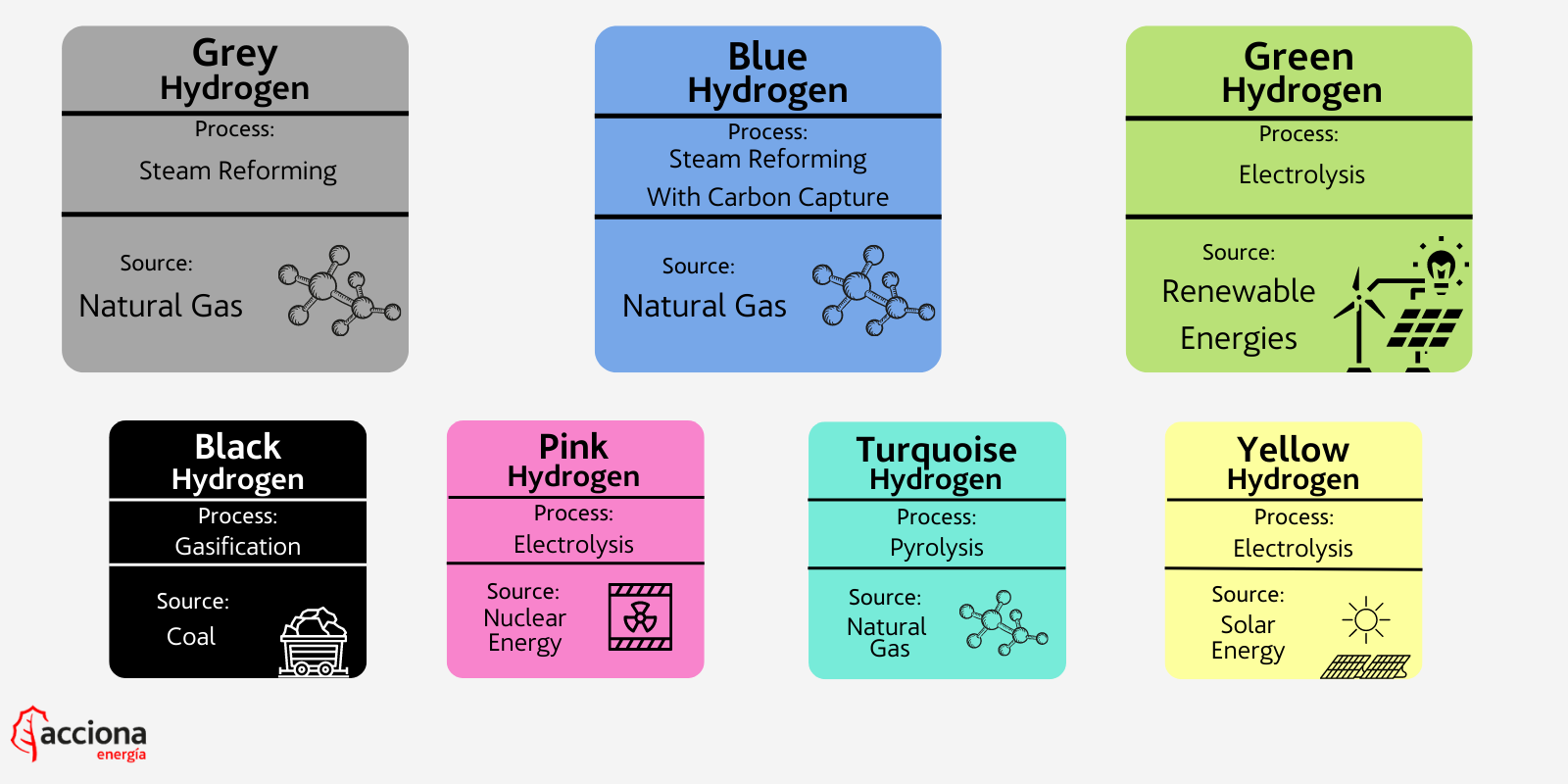- Australia
- Go to acciona.com
- From green to pink hydrogen, we take you through the rainbow that is hydrogen colours and crack the colour code on what each one means.

In a previous blog, we discussed what hydrogen is and why everyone’s talking about it. There we spoke about how hydrogen is the most abundant element in the universe, being present in 75% of all matter. It’s light, can be stored, and doesn’t generate any pollution by itself. All of this makes it a perfect candidate to become a fuel source. However, hydrogen does not begin as an energy source, but as an energy vector. This means it needs a chemical process to extract it and turn it into fuel. There are many ways to complete this process, but unfortunately, not all of them are sustainable.
This is where the colour classification of hydrogen comes in. But isn't Hydrogen a colourless gas? Yes, but each colour corresponds to a different extraction process.
The three most common types of hydrogen are grey, blue, and green hydrogen.
Grey
Grey hydrogen is currently the most common, and the cheapest, form of hydrogen production. It is used as a fuel and doesn't generate greenhouse gas emissions itself, but its production process does. Grey hydrogen is created from natural gas using steam reforming, which separates the hydrogen from the natural gas. However, the technologies used don’t capture the carbon emissions created during the process, which are instead released into the atmosphere.
Blue
Blue hydrogen is also extracted using the steam reforming process, but it differs from grey as the carbon emissions released are captured and stored, which reduces the emissions in the atmosphere, but doesn’t eliminate them. Blue hydrogen is sometimes called ‘low-carbon hydrogen’ as the production process doesn’t avoid the creation of greenhouse gases, just stores them away.
Green
Green hydrogen doesn’t generate any emissions in its entire life cycle as it uses renewable energies in the production process, making it a true source of clean energy. It is made by electrolysing water using clean electricity created from surplus renewable energy from wind and solar power. The process causes a reaction that splits water into its components of hydrogen and oxygen (the H and O in H2O). This results in no carbon emissions being released in the process. It’s a great alternative to grey and blue, but for now the main challenge is in reducing the production costs of green hydrogen to make it a truly obtainable renewable and environmentally friendly alternative.
Beyond the three biggest types of hydrogen, there's a whole array of other colour options.
Black and Brown
Black and brown hydrogen is created using either type of coal in the extraction process. This process, called gasification, is the process on the opposite end of the spectrum from green hydrogen’s electrolysis. It’s an established process used in many industries that convert carbon-rich materials into hydrogen and carbon dioxide. The emissions are then released into the air, causing pollution and becoming the most harmful hydrogen for the environment.
Pink
Pink hydrogen is extracted through electrolysis powered by nuclear energy. You may hear pink hydrogen also referred to as purple or red hydrogen.
Turquoise
Turquoise hydrogen is very new and is still in the process of discovering if it can be used well at a large scale. It's made using a process called ‘methane pyrolysis’, which produces hydrogen and solid carbon by using heat to break down a material’s chemical makeup. No carbon is released into the air, instead it’s stored in the solid carbon created. If proven to be effective, turquoise may join blue as a ‘low-carbon hydrogen’ if the carbon can be permanently stored in an environmentally safe way.
Yellow
Yellow hydrogen is another new entry and is made through electrolysis specifically using solar power, similar to the process used to create green hydrogen, but with a sunnier name.
White
White hydrogen is found naturally in underground deposits of geological hydrogen. It’s extracted through a process called fracking, which is the process of drilling into the earth and directing a high-pressure mix of water, sand, and chemicals at the rock to release the gas inside. At the moment there are no plans to use this type of hydrogen as an energy source.
Our goal, as a leading provider of green energy infrastructure, is to create a truly sustainable energy industry by helping switch to renewable energy options and processes.
Find out more about ACCIONA Energia's hydrogen and other renewable energy projects globally and locally.